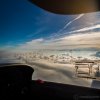cowman
Final Approach
Anyone got any tips for this? We've taken a few with our iPhones and they always seem to come out blurry and dim. You can never really see the cool view we thought was photo worthy at the time.
I have a decent DSLR- a Nikon d3100. I don't think we've tried using it yet so maybe that would get better results. Wondering if there are any settings/filters/lenses that might be more ideal than the basic novice stuff we use.
I have a decent DSLR- a Nikon d3100. I don't think we've tried using it yet so maybe that would get better results. Wondering if there are any settings/filters/lenses that might be more ideal than the basic novice stuff we use.














